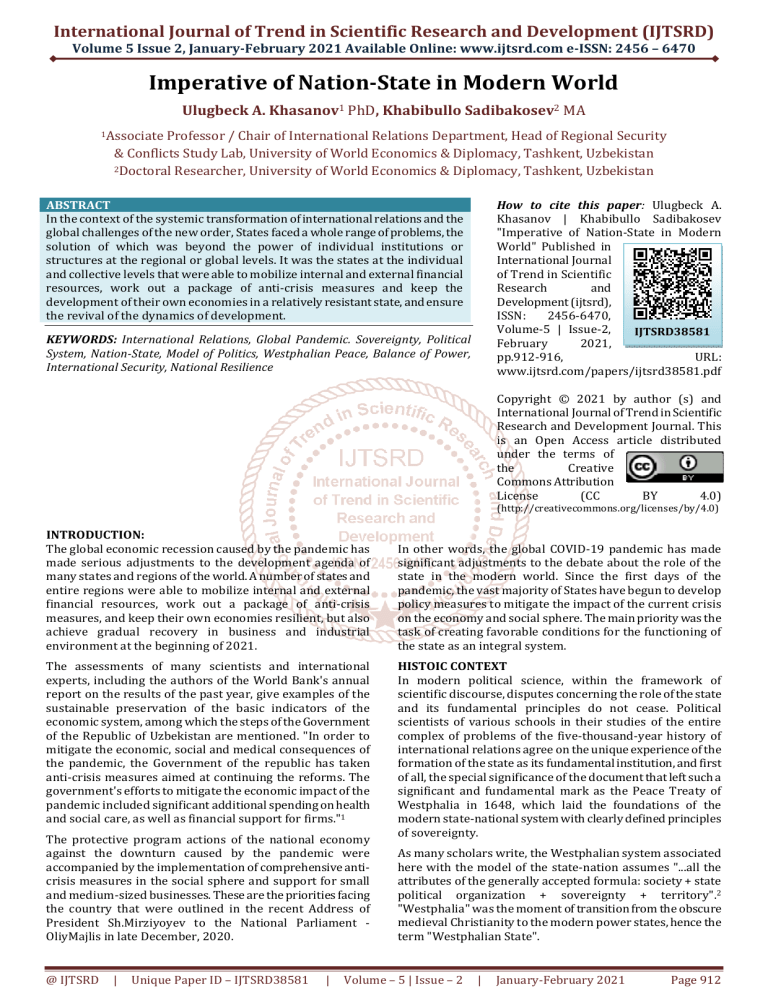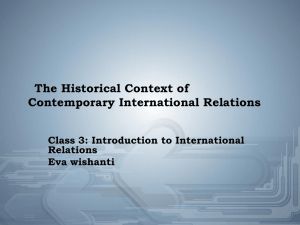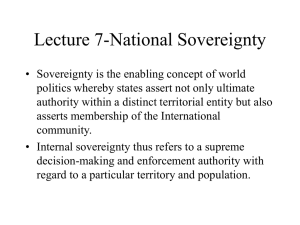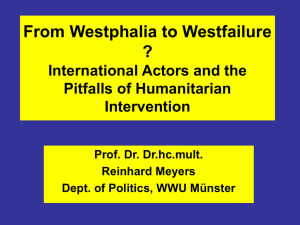
International Journal of Trend in Scientific Research and Development (IJTSRD)
Volume 5 Issue 2, January-February 2021 Available Online: www.ijtsrd.com e-ISSN: 2456 – 6470
Imperative of Nation-State in Modern World
Ulugbeck A. Khasanov1 PhD, Khabibullo Sadibakosev2 MA
1Associate
Professor / Chair of International Relations Department, Head of Regional Security
& Conflicts Study Lab, University of World Economics & Diplomacy, Tashkent, Uzbekistan
2Doctoral Researcher, University of World Economics & Diplomacy, Tashkent, Uzbekistan
How to cite this paper: Ulugbeck A.
Khasanov | Khabibullo Sadibakosev
"Imperative of Nation-State in Modern
World" Published in
International Journal
of Trend in Scientific
Research
and
Development (ijtsrd),
ISSN:
2456-6470,
Volume-5 | Issue-2,
IJTSRD38581
February
2021,
pp.912-916,
URL:
www.ijtsrd.com/papers/ijtsrd38581.pdf
ABSTRACT
In the context of the systemic transformation of international relations and the
global challenges of the new order, States faced a whole range of problems, the
solution of which was beyond the power of individual institutions or
structures at the regional or global levels. It was the states at the individual
and collective levels that were able to mobilize internal and external financial
resources, work out a package of anti-crisis measures and keep the
development of their own economies in a relatively resistant state, and ensure
the revival of the dynamics of development.
KEYWORDS: International Relations, Global Pandemic. Sovereignty, Political
System, Nation-State, Model of Politics, Westphalian Peace, Balance of Power,
International Security, National Resilience
Copyright © 2021 by author (s) and
International Journal of Trend in Scientific
Research and Development Journal. This
is an Open Access article distributed
under the terms of
the
Creative
Commons Attribution
License
(CC
BY
4.0)
(http://creativecommons.org/licenses/by/4.0)
INTRODUCTION:
The global economic recession caused by the pandemic has
made serious adjustments to the development agenda of
many states and regions of the world. A number of states and
entire regions were able to mobilize internal and external
financial resources, work out a package of anti-crisis
measures, and keep their own economies resilient, but also
achieve gradual recovery in business and industrial
environment at the beginning of 2021.
The assessments of many scientists and international
experts, including the authors of the World Bank's annual
report on the results of the past year, give examples of the
sustainable preservation of the basic indicators of the
economic system, among which the steps of the Government
of the Republic of Uzbekistan are mentioned. "In order to
mitigate the economic, social and medical consequences of
the pandemic, the Government of the republic has taken
anti-crisis measures aimed at continuing the reforms. The
government's efforts to mitigate the economic impact of the
pandemic included significant additional spending on health
and social care, as well as financial support for firms."1
The protective program actions of the national economy
against the downturn caused by the pandemic were
accompanied by the implementation of comprehensive anticrisis measures in the social sphere and support for small
and medium-sized businesses. These are the priorities facing
the country that were outlined in the recent Address of
President Sh.Mirziyoyev to the National Parliament OliyMajlis in late December, 2020.
@ IJTSRD
|
Unique Paper ID – IJTSRD38581
|
In other words, the global COVID-19 pandemic has made
significant adjustments to the debate about the role of the
state in the modern world. Since the first days of the
pandemic, the vast majority of States have begun to develop
policy measures to mitigate the impact of the current crisis
on the economy and social sphere. The main priority was the
task of creating favorable conditions for the functioning of
the state as an integral system.
HISTOIC CONTEXT
In modern political science, within the framework of
scientific discourse, disputes concerning the role of the state
and its fundamental principles do not cease. Political
scientists of various schools in their studies of the entire
complex of problems of the five-thousand-year history of
international relations agree on the unique experience of the
formation of the state as its fundamental institution, and first
of all, the special significance of the document that left such a
significant and fundamental mark as the Peace Treaty of
Westphalia in 1648, which laid the foundations of the
modern state-national system with clearly defined principles
of sovereignty.
As many scholars write, the Westphalian system associated
here with the model of the state-nation assumes "...all the
attributes of the generally accepted formula: society + state
political organization + sovereignty + territory".2
"Westphalia" was the moment of transition from the obscure
medieval Christianity to the modern power states, hence the
term "Westphalian State".
Volume – 5 | Issue – 2
|
January-February 2021
Page 912
International Journal of Trend in Scientific Research and Development (IJTSRD) @ www.ijtsrd.com eISSN: 2456-6470
In a less simplistic way, many scientists have intelligently
described the complexity of the Westphalia phenomenon
and the abundance of its meanings. An example of this is the
following thought of the great American international lawyer
Richard Falk3: "Westphalia" is simultaneously used to refer
to an event, an idea, a process, and a normative evaluative
principle. As an event, Westphalia refers to the peace
settlement concluded at the end of the Thirty Years ' War
(1618-1648), which also served to establish the structural
basis for the preservation of the world order, which has
changed from time to time, to the present. As an idea,
Westphalia refers to the state-centric nature of the world
order, based on the equal participation of members, granted
exclusively to geographically located sovereign states. As a
process, Westphalia refers to the changing nature of the state
and public administration as it has evolved over the past 350
years since the conclusion of the treaties, with major
milestones such as colonialism and decolonization, the
emergence of new types of weapons, the establishment of
international institutions and structures, the growth of
global market mechanisms, and the emergence of new
transformational processes in the world."4
However, the Westphalian Treaties themselves have never
been considered as the origin of the modern state or nationstate, and, therefore, the term "Westphalian State" has
always been conditional. To understand its character and
peculiarity is possible only with a separate analysis of the
circumstances, causes and ramifications of the era of the
Thirty Years ' War for Europe.
The true significance of the nation-state model in its
"Westphalian" interpretation lay in the territorial design of
Europe, which was accompanied by the formation of a statecentric system that would later dominate international
relations and that these changes would determine the
emergence of modern sovereign states-nations with rigidly
fixed borders, which had not previously been observed.
It should be emphasized that the events of that era affected
the fate of many peoples and faced a whole complex of
problems that directly determined the very existence and
security of entire states. They formed the basis of what is
commonly portrayed by modern scholars as the Westphalian
Model, implying "a community of States based on the
principle of territorial sovereignty".5 Legal scholars call this
the "principles of national sovereignty", which means
mandatory legal equality and autonomy, non-interference in
the affairs of other states, territorial integrity and
inviolability of borders, as conditions for the stable and
sustainable development of each national subject of
international relations. Today, these principles form the
basis of the UN Charter, a universally recognized institution
of the international security system (Article 2.7 of the UN
Charter).6
The long and largely contradictory history of international
relations shows that the principles of the Peace of
Westphalia could not immediately regulate the nature and
typology of relations between states, create their stable
structure. The Westphalian world and its significance for the
subsequent development of world politics, economics and
law should be understood as a certain process or model of
the development of the international system, since it was
based on a fundamentally new, deterministic player - the
national state-designated in Western political science by the
term "Nation-State".7
@ IJTSRD
|
Unique Paper ID – IJTSRD38581
|
The outstanding American scientist, the founder of the
school of political realism, Hans Morgenthau, saw the
phenomenon of the Westphalian world, first of all, in the fact
that "...the territorial state has become the cornerstone of the
modern state system"8, recognizing the "system of sovereign
states" as the basis of the "new world order".9 Thus, leading
international scholars sought to emphasize the importance
of the emergence of the concept of state sovereignty,
although "...nowhere in the treaties does the word
'sovereignty' itself appear, especially since there is no such
word in Latin, the language in which the treaties were
originally written."10
In fact, when the French delegation proposed inclusion of
sovereignty term in the treaties, such idea was immediately
rejected. While the treaties do mention the law of "territorial
jurisdiction" of states, it is crucial to keep in mind that this
jurisdiction was subject to an external legal regime, namely
the Holy Roman Empire. "The political entities within the
Holy Roman Empire were not sovereign states in the modern
sense, and that is characterized by Westphalian
sovereignty".11
Such examples clearly reflect the nature of international
communication in the late Middle Ages, when the primacy of
empires persisted until 1806, which confirms the idea of the
uniqueness of the phenomenon of the Westphalian world as
a process of forming state sovereignty as a kind of Modus
Vivendi12 or universal model of both statehood and the
entire system of international relations in a community of
equals.
HOLISTIC VIEW
The emergence of sovereign states in Europe was a gradual
phenomenon and was not the spontaneous result of any
revolutionary breakthrough brought about by the Peace of
Westphalia. Ultimately, as a model, it reflected the concept of
sovereignty, which underwent a significant transformation
during the nineteenth and twentieth centuries. Having the
base, international scholars rightly credited with the
formation of the phenomenon of the Westphalian state
model of the Westphalian world, especially in the context of
the analysis and understanding of the modification and
transformation of the new architecture of the world order
after world war II under developing by the time of the
bipolar system, and later, the reasons for its collapse and the
activation of new political processes in the world, and in fact
it continues to influence the discourse on contemporary
issues in international relations in the scientific community.
On the other hand, traditional sovereign equality, which does
not take into account the behavioral lines of States, since
violations of the Westphalian model were a constant and
recurring feature of international relations. The Westphalian
model never served as a panacea and could not explain the
deviant nature of situations in which sovereign inequality
manifested itself in the course of many local and global
conflicts. This is also necessary, given the processes of
globalization and growing interdependence that continue to
challenge the established model of Westphalian sovereignty.
Many political scientists argue that it is at this time that the
consolidation of the nation-states in Europe takes place. Paul
Kennedy, authoritative expert on this issue, says: "Between
the end of the XV and XVII centuries in most European
countries was observed centralization of political and
military power, usually under the authority of the monarch,
and in some places under the rule of a local Prince or
Volume – 5 | Issue – 2
|
January-February 2021
Page 913
International Journal of Trend in Scientific Research and Development (IJTSRD) @ www.ijtsrd.com eISSN: 2456-6470
Mercantile oligarchy, accompanied by the increase in the
powers and methods of state taxation and carried out far
more complicated bureaucracy... This evolution of the
European nation-state has been driven by various causes.
Economic changes have already undermined much of the old
feudal system...). The Reformation, in the division of
Christendom (...) the spread of secularism on a national
basis. The decline of Latin and the increasing use of
vernacular languages by politicians, lawyers, bureaucrats,
and poets reinforced this secular trend. (... it is not surprising
that many philosophers and other writers of the time
considered the nation-state to be the natural and best form
of civil society...). But it was the war and its consequences
that put a much more urgent and constant pressure on
"nation-building" than these philosophical considerations
and slowly developing social trends."13
Paul Kennedy, speaking of "philosophers and writers"14,
refers to Machiavelli, most likely the first to use - at the
beginning of the XVI century – the term state in its modern
interpretation, as well as Hugo Grotius, who in 1625 - in the
middle of the Thirty Years ' War - published his folio "Three
books on the law of war and peace", in which he describes
states as legal individuals and designates one of the first
legal principles of international law (jusgentium). Later, in
1651, after the Peace of Westphalia, the English philosopher
Thomas Hobbes developed a complex theory of the state in
his famous work "Leviathan".15
Despite the relative independence of the princes in relation
to the supervision of the emperor, they were unable to
defend their own territorial autonomy, and that inevitably
affected the political fragmentation and delayed for two
whole centuries the emergence of the German state. In fact, it
was only in the mid - 19th century that the emergence of two
great European Countries - Italy in the 1860s and 70s and
Germany in the 1870s-appeared on the world map, precisely
at a time when the state-national system had already begun
to dominate European geopolitics. Therefore, the difference
between a princely state and a modern nation-state is
primarily related to the issue of sovereignty. After all, lawmaking, tax collection, the collection of soldiers, and the
conduct of wars were all considered the powers of the
sovereign. The right to form alliances is another prerogative
of the sovereignty of princes. These are the arguments that
supported the theses of many authors of that era that it was
the Peace of Westphalia that served as the impetus and
source of the emergence of a sovereign state.
The influence of the great French thinker Jean Bodin on the
theoretical concept of sovereignty is well known, namely in
his work "Six Books on the State", published in 1576, seventy
years before the Westphalian Congress, which confirms the
thesis of N. Machiavelli on the sovereignty of the prince,
which also dates back to the XVI century. Bodin writes:
"When Machiavelli published The Prince in 1527, he was the
first to give an overview of the international community...He
begins by describing the fact that the principalities recognize
neither law nor authority over themselves, thereby declaring
the uselessness of the cultural heritage of the medieval
Christian republic."16
It can be argued that the fact that "Westphalia" recognizes
the right of princes to form alliances for security and that the
immanent feature of the modern state associated with its
right to declare and wage war is its sovereignty.
@ IJTSRD
|
Unique Paper ID – IJTSRD38581
|
Another name for the Westphalian state is "territorial state".
Researchers
refer
to
"territorial
superiority",
justerritoriale17, such political entities are not integral and
not incorporated, since they do not bring anything new to
the Empire, but rather contradict it. There was a territorial
demarcation of religious faith defined by the princes, but
Westphalia introduced an amendment and supplemented it
with the concept of political demarcation or "territorial
demarcation".18
NATION-STATE AS A MODEL
The general consensus among international experts is based
on the idea that the Peace of Westphalia has clarified the
definition of a national, sovereign, secular, territorial state,
although it does not claim that sovereignty is its creation.
Many authors emphasize the novelty caused by the
"Westphalian system", which was consistent, that its
contours acquired clear outlines already in the XX most
clearly.19 It is easy to list the features of such a system: statecentered, formed, as we have already emphasized, by
sovereign nation-states, equal, protected by the principles of
non-interference, with centralized administrations and
secularized institutions; relations between these state
entities are subject to the principle of balance of power and
are regulated on its basis by international law.20
On the basis of a critical analysis, it would be important to
focus on two of its distinctive features: state-centric, as well
as the principle of balance of power. The school of
Neorealism in international relations prefers a systematic
analysis of international relations, and scholars often refer to
the system as the result of the order established after the
Peace of Westphalia and where the system is state-oriented.
The post-Westphalian European order was not a
homogeneous state-centered system. The situation in
Europe from the middle of the XIX century onwards is
ambiguous - some nation-states were state-centric,
reminiscences of the Holy Empire, which retained many of
its structures, and hundreds of other polices with varying
degrees of autonomy. The fragmentation of geographical and
political space in Europe became evident due to the variety
of names of the polis that existed at that time: lordships,
imperial cities, counties, baronies, principalities, duchies,
landgraves, imperial valleys, kingdoms, free cities,
archduchies, abbeys, bishoprics, archbishoprics, margraves,
etc.
Klaus Malettke21, a German scholar, describes the German
territory at that time as follows: "The whole Empire included
in the seventeenth century thousands of more or less
autonomous states. On the one hand, this group included
about three hundred states or similar structures, whose
lords - secular and non - secular-elected lords, princes,
imperial counts and abbots, magistrates of the imperial free
cities-all had territorial jurisdiction over their territories that
were directly dependent on the Empire, that is, had the right
of representation in the Imperial Seim. On the other hand, it
included the Imperial Cavalry, which had neither
representation nor voting rights in the Imperial Seim, but
had jurisdiction over its small, even micro-territories, special
possessions, totaling more than a thousand."22 This fact
confirms the fact that their autonomy is limited - not the
ability to independently create defense structures and
ensure their own security as a prerequisite for the principle
of sovereignty.
Volume – 5 | Issue – 2
|
January-February 2021
Page 914
International Journal of Trend in Scientific Research and Development (IJTSRD) @ www.ijtsrd.com eISSN: 2456-6470
The famous researcher Geoffrey Parker23 refers to the
correspondence of Adler Salvius and Jean Oxenstiern,
Swedish diplomats, plenipotentiaries in Osnabruck: "As
Count Salvius testily reported to his confidants at the
congress at the end of 1646:" people are beginning to see
that the power of Sweden is dangerous for the balance of
power." Their first rule of policy is that the security of all
depends on the balance of individuals. When a person begins
to become powerful ... others place themselves, through
unions or alliances, in the opposite balance to maintain
balance. But the idea was hardly new. As early as 1632, the
papal curia informed its diplomats abroad that the "interests
of the Roman Church" were better served by the balance of
power than by the victory of any particular State. And this
was a principle to which Sweden itself had often resorted in
the old days: in 1633.The Chancellor of Oxenstierna told a
foreign official that the main purpose of the Swedish
intervention in Germany was "...to preserve the balance in all
of Europe."24
The European balance of power, of course, "...did not flow
directly from the Westphalian Treaties at that time, but it did
not develop in Europe until the end of the 17th century, not
without the participation of such factors and circumstances,
when the rise of France forced other European states to join
forces against Louis XIV (1643-1715)".25 Admittedly, the
principle of balance of power has always been present in the
logic of the events of the Thirty Years' War and the
subsequent European territorial reorganization.
The proposed thesis, according to which the state-nation, in
the modern sense of the term, is the result of the merger of
such elements as the end of the old medieval model until the
beginning of the French Revolution on the one hand, and on
the other - the emergence in world history of such a concept
as the new time - the birth of bourgeois relations, industrial
capitalism and the beginning of the process of
industrialization.
Therefore, analyzing the structure of changes in the
economic development of Europe in the XVII century, it can
be argued that the origin of the modern state-nation lies in
the merger of national-state construction and the emergence
of industrial society, when the structure of industrial
production, in fact, led to a change in the size of the
territories over which there was political control, since it is
the change in the state territory that affects the nature of the
economic and industrial space. Thus, it can be argued with
good reason that, in contrast to the previous "...world
economy, the most adequate political organization for
industrial capitalism was the nation-state, when the internal
market, controlled by political power, was the basis for the
accumulation of capital."26 After all, it is the economic space
in an industrial society that is associated with an internal
market of considerable size, based on state regulation.
The transition to a modern state-nation revealed the
solution of the most important issue-the legitimacy of
power-taking into account the fact that the traditional source
of legitimacy (dynasty, heredity and heritage) turned out to
be untenable in the new conditions. Sovereignty was no
longer determined in the monarch, but in the people, in
society, and therefore the state "...is supported by a sense of
nationalism, which is the source of the legitimacy of the
power of the new bourgeoisie."27
@ IJTSRD
|
Unique Paper ID – IJTSRD38581
|
SIGNIFICANCE OF THE MODEL
The modern state-national system was formed in those
transitional societies through which they passed when they
broke away from the ancient model of the state, namely in
France, Great Britain and the United States of America, as
well as in countries where industrial production became
increasingly dynamic and dominant, which occurred during
the XVIII and XIX centuries, and according to some estimates,
up to the XX century.
The true diplomatic skill of a peaceful settlement was to
prioritize the legal rather than the military means of
resolving disputes. This meant that princes could no longer
impose their faith on their subjects, and princes who
converted to another denomination could no longer change
the confessional status of their territory. This was an
effective message to restore trust between Protestants and
Catholics. "Since the Catholic Imperial estates outnumbered
the Protestant ones, it was decided that a majority vote
would no longer be decisive in representative bodies such as
the Reichstag (Imperial Seim) on confessional matters.
Instead, the representatives of the princes were to divide
into religious parties and reach a settlement through direct
negotiations. This principle of confessional parity was also
applied to the imperial judicial system, with the Protestant
members of the two supreme courts being granted a de facto
veto".28
An important principle of the State-centric system was the
recognition that peace would only last if external guarantors
collectively ensured that States respected the fundamental
rights of their peoples to religion, property and due process.
One of the key legacies of the Westphalian system was its
innovative system of guarantors, which enabled the
signatories to enforce the terms of the settlement and to
create a system of collective security29 that encompassed
both internal guarantors (the emperor and the princes) and
external guarantors (France and Sweden). The latter
integrated this system into the broader international order
of early modern Europe.
This guarantee was most noticeable when the "...integrity
and constitutional balance of the empire was threatened,
which in some cases came from one or more of the
guarantors themselves-especially from the French monarch
Louis XIV in the second half of the 17th century".30 The
guarantors, who were not parties to the dispute, usually
entered into it and defended the Westphalian Order-either
out of principled beliefs, geopolitical interests, or a
combination of both.
The system of guarantors also proved able to evolve and
grow in response to changing international currents:
"...Sweden's geopolitical decline during the 18th century
made it less able to effectively implement guarantees
(although it formally maintained its full status until the
collapse of the empire in 1806), while the growing power of
Russia elevated it to the status of a guarantor in 1779".31
It was the norms established by Westphalia that served as a
deterrent even if they were violated. For example, the
question of treaty violation was discussed, including by the
king himself, from the point of view of Westphalian norms,
with his inherent prejudice towards peace. "Ultimately, Louis
XIV's geopolitical adventures ended in failure, and the norms
of behavior fixed by the Peace of Westphalia played a major
role in curbing his ambitions and uniting other European
states in an alliance against him."32
Volume – 5 | Issue – 2
|
January-February 2021
Page 915
International Journal of Trend in Scientific Research and Development (IJTSRD) @ www.ijtsrd.com eISSN: 2456-6470
Thus, the success of the guarantor system was partly due to
the widespread normative recognition of external
interference to protect rights and freedoms. In addition, the
Empire had a corresponding ingrained tradition of seeking
foreign aid. This, along with the state-centric nature of
relations, helped to make the institution of external
guarantors effective and highly demanded, and, in turn,
strengthened the further development of the balance of
power policy as the most important stabilizing factor of the
entire system of international relations.
CONCLUSION
The nation-state model is largely based on the definition of
the concept of state sovereignty in the XIX and XX centuries.
It is also extremely important to note that the logical
connection between the Westphalian world and the
emergence of a system of sovereign states is not only
historically justified, but also helps to better understand the
systemic political structures prevailing in modern world
political processes.
The principles of the Peace of Westphalia served as the most
important systemic impetus for the formation of a new
model of international relations based on the role of a
sovereign, national state. This process covers the following
centuries the development of the world system, the actions
of which depended on the formation and the subsequent
transformation of its structure, the emergence of new
sovereign States, their role and importance in the political
map of the world, and, in General, the dynamics of the
development of almost all complex political processes in the
world, new denoting them special in many ways unique to its
role in contemporary international relations.
Literature Reference:
[1] World Bank Country overview Uzbekistan:
https://www.worldbank.org/en/country/uzbekistan
/overview
[2]
[3]
Mulcaire C. How ‘Westphalian’ is the Westphalian
Model? https://www.e-ir.info/2014/02/03/howwestphalian-is-the-westphalian-model/
Falk R. Revisiting Westphalia, Discovering PostWestphalia The Journal of Ethics 6 (4):311-352
(2002) https://philpapers.org/rec/FALRWD
[13]
Kennedy, Paul (1989). The Rise and Fall of the Great
Powers. Economic Change and Military Conflict from
1500 to 2000, London: Fontana Press.
https://cheirif.files.wordpress.com/2015/08/paulkennedy-the-rise-and-fall-of-the-great-powers19891.pdf
[14]
Ibid.
[15]
Ibid.
[16]
Гугняк В. Жан Боден (1530-1596) Как
Представитель Раннего Меркантилизма. Москва,
2015
https://lawjournal.ru/files/pdf/201505/201505_80.pdf
[17]
Falk R. Revisiting Westphalia, Discovering PostWestphalia The Journal of Ethics 6 (4):311-352
(2002) https://philpapers.org/rec/FALRWD
[18]
Ibid.
[19]
Kennedy, Paul (1989). The Rise and Fall of the Great
Powers. Economic Change and Military Conflict from
1500 to 2000, London: Fontana Press.
https://cheirif.files.wordpress.com/2015/08/paulkennedy-the-rise-and-fall-of-the-great-powers19891.pdf
[20]
Ibid.
[21]
Malettke K. The Westphalia Peace Treaties and the
Political Organization of the Holy Roman Germanic
Empire
https://www.cairn-int.info/journal-dixseptieme-siecle-2001-1-page113.htm?contenu=resume
[22]
Ibid.
[23]
Parker, Geoffrey (1988). The Thirty Years' War. New
York:
Routlege&
Kegan
Paul
Inc.
https://digitalcommons.georgefox.edu/cgi/viewcont
ent.cgi?article=1016&context=seminary_masters&htt
psredir=1&referer=
[24]
Ibid.
[25]
Ibid.
[26]
Федотова В. Г., Колпаков В. А., Федотова Н. Н.
Глобальный
капитализм:
три
великие
трансформации. — М.: Культурная революция,
2008.
—
608
с.
https://iphras.ru/uplfile/root/biblio/kapitalizm_200
8.pdf
[4]
Ibidem
[5]
Krasner, S. D. ‘Compromising Westphalia’ in
International
Security,
Vol.
20:
3
file:///C:/Users/User/Downloads/Krasner%20%20Compromising%20Westphalia.pdf
[27]
Ibid.
[6]
Ibid.
[28]
Ibid.
[7]
Ibid.
[29]
[8]
Morgenthau, H. Politics Among Nations: The Struggle
for Power and Peace, New York: McGraw-Hill
http://saldanha.pbworks.com/f/Morgenthau.Politics
+Among+Nations.pdf
Falk R. Revisiting Westphalia, Discovering PostWestphalia The Journal of Ethics 6 (4):311-352
(2002) https://philpapers.org/rec/FALRWD
[30]
Ibid.
[31]
Kennedy, Paul (1989). The Rise and Fall of the Great
Powers. Economic Change and Military Conflict from
1500 to 2000, London: Fontana Press.
https://cheirif.files.wordpress.com/2015/08/paulkennedy-the-rise-and-fall-of-the-great-powers19891.pdf
[32]
Ibid.
[9]
Ibid.
[10]
Mulcaire C. How ‘Westphalian’ is the Westphalian
Model? https://www.e-ir.info/2014/02/03/howwestphalian-is-the-westphalian-model/
[11]
Ibid.
[12]
Ibid.
@ IJTSRD
|
Unique Paper ID – IJTSRD38581
|
Volume – 5 | Issue – 2
|
January-February 2021
Page 916







